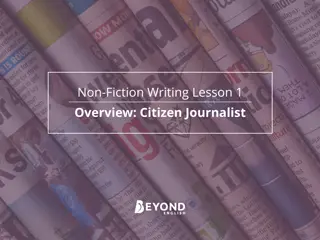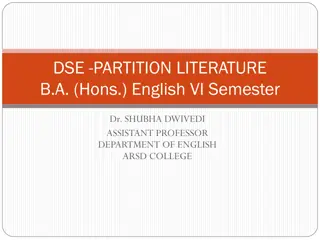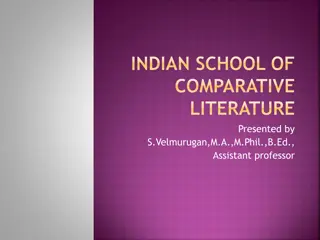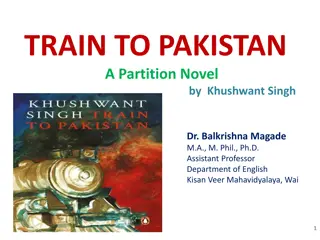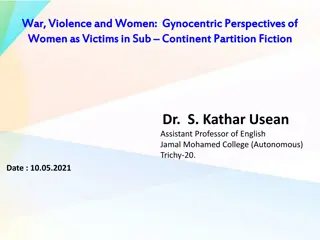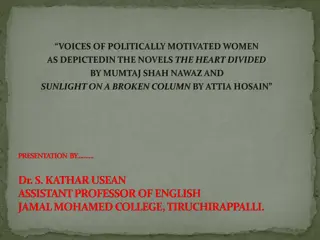Exploration of Partition Literature in Indian English Fiction
Political partition in India led to a significant literary genre known as Partition Literature. This genre explores the socio-historical impact of the partition era through novels and short stories, offering alternative histories and personal perspectives on this defining event. Notable works by authors like Salman Rushdie, Anita Desai, and Bhishm Sahani capture the human side of history and challenge official narratives, showcasing the lasting effects of partition on individuals and communities.
Download Presentation

Please find below an Image/Link to download the presentation.
The content on the website is provided AS IS for your information and personal use only. It may not be sold, licensed, or shared on other websites without obtaining consent from the author.If you encounter any issues during the download, it is possible that the publisher has removed the file from their server.
You are allowed to download the files provided on this website for personal or commercial use, subject to the condition that they are used lawfully. All files are the property of their respective owners.
The content on the website is provided AS IS for your information and personal use only. It may not be sold, licensed, or shared on other websites without obtaining consent from the author.
E N D
Presentation Transcript
DSE -PARTITION LITERATURE B.A. (Hons.) English VI Semester Dr. SHUBHA DWIVEDI ASSISTANT PROFESSOR DEPARTMENT OF ENGLISH ARSD COLLEGE
A General Introduction A General Introduction The political partition of India caused one of the great human convulsions of history. Urvashi Butalia, The Other Side of Silence Partition was the defining event of modern, independent India and Pakistan, and it is hardly an exaggeration to say that partition continues to be the defining event of modern India and Pakistan. - Gerald James Larson, India s Agony Over Religion
PARTITION FICTION PARTITION FICTION Partition fiction, over the years has evolved into a distinct sub-genre within the Indian English Fiction. It draws upon the socio-historical political reality of the partition era. Most of the stories and the novels under this category adhere to a basic narrative pattern of order-disorder-order. The similar narrative pattern can be explained through novelist Chaman Nahal s three-fold narrative division of his monumental work Azadi- The Lull, The Storm, and The Aftermath. Apparently, most of the writers of this aesthetic block take a secular humanist view of Indian history. To quote Sukrita Paul Kumar, the partition fiction led to a revival and, to borrow, Foucault s words, a resurgence of hidden suppressed histories that destabilise and challenge the official ones. Partition narratives bear a testimony to the gruesome past, also offer a subjective response to the horrific episode, capture the personal side of history and thus offer am alternative history of partition.
Novels On The Theme Of Partition Novels On The Theme Of Partition Bhishm Sahani- Tamas Bapsi Sidhwa-Cracking India Bapsi Sidhwa-Ice-Candy Man Anita Desai -Clear Light of Day Salman Rushdie- Midnight s Children Ismat Chugtai-Lifting The Veil Amitav Ghosh- The Shadow Lines Kamleshwar- Partitions Krishna BaldevVaid-The Broken Mirror Rajendra Prasad- India Divided Khuswant Singh- Train to Pakistan Chaman Nahal- Azadi Debi Dayal- A Bend in the Ganges Gurcharan Das- A Fine Family Attia Hosain- Sunlight on a Broken Column Mumtaz Shah Nawaz-The Heart Divided
Short Stories About The Partition Short Stories About The Partition The form of the short story became immensely popular in the 1940s and 50s in the sphere of Hindi and Urdu literature and documented the individual s and the community s trauma during and after partition. Partition is seen as a seismic and disruptive phenomenon. The stories vividly describe the felt and the lived experience while evoking the memories and recording the emotional responses insinuated by the rupture. The discord has been delineated with the help of aural and visual images.The visual images distinctly bring out the fear of the people, the grotesqueness of arson and killing in the wake of the communal disharmony in full intensity.
Stories About The Partition Stories About The Partition Cold Meat - Sa adat Hasan Manto Open It - Sa adat Hasan Manto Banished -Jamila Hashmi Lajwanti -Rajinder Singh Bedi Stony Hearted -AshfaqueAhmad Peshawar Express -Krishan Chander Pinjar -Arita Pritam We have arrived in Amritsar -Bhisham Sahni Malbe Ke Malik (His Heap of Rubble)-Mohan Rakesh How Many Pakistans? - Kamleshwar A letter From India -Intizar Husain Sleepwalkers -Joginder Paul Ravi Paar -Gulzar
Movies on Partition Movies on Partition Garam Hawa Tamas Khamosh Pani Midnight s Children Bhaag Milkha Bhaag Gadar-Ek Prem Katha Earth (1998) Pinjar Sardar Train To Pakistan Hey Ram
A Leaf In The Storm A Leaf In The Storm - -Lalithambika Lalithambika Antharjanam Antharjanam Keywords: women and the partition, social conditioning, engendred roles, deprivations, no or little access to education, partition, displacement, loss, destabilization of inter-community relations, friendship, deceit, betrayal, violence, violation, abduction, recovery, rejection, perception of body, purdah, discourse of honour, women s sexual purity, national virtue, exclusion of female victims of partition, patriarchal discourse of colonialism/ nationalism, the other, infanticide, motherhood, personal memory
Lalithambika Lalithambika Antherjanam s Antherjanam s Life (1909 Life (1909- -1987) 1987) Born and brought up in a traditional Namboodiri household in Kollam district of Kerala, Antherjanam was a writer and social reformer who worked for the awakening and empowerment of women through her writings in Malyalam. Her second name Antherjanam was the term used for women in the Namboodiri Brahmin caste, literally meaning people who live inside. She produced nine volumes of short stories, six anthologies of poems, two books for children and a novel, Agnisakshi for which she was honoured with the Kendra Sahitya AkademiAward and Kerala SahityaAkademiAward. Her autobiography titled as AathmakadhakkoruAamukham is a significant work written in Malyalam. An outspoken critic of the oppression of women in Namboodiri society and of the blatant double standards of sexual morality it practiced. Lalithambika was born into a family of writers deeply involved in the early twentieth century movements for the transformation of Namboodiri society. Throughout her writing career, she talked about the ennui, derision, subordination, and sexual exploitation faced by women who were confined in the mudupadam, or traditional household. Her fiction engages with issues of caste, class, gender and nationalism in a forceful manner. A powerful feminist voice, Antherjanam has enriched the feminist discourse through her rebellious characters and their critical engagements with the social issues.
Published in 1948, the plot of Kodumkattilpetta Orila (A leaf in the Storm) by LalithambikaAntherjanam brings into discussion women and the trauma of partition. The story narrativizes unwritten histories of suffering that erupted from the partition and continued over subsequent years. The story explores the issues of national honour, patriarchal values and communalized identities in relation to women subjects. Antherjanam further brings to the fore issues such as annihilation of female subjectivity and individuality at the cost of national honour. Antherjanam s story delineates the fate of dishonored, violated and humiliated women and breaks the silence surrounding sexually abused women and the denial of their citizenship. The narrative portrays women s experience of displacement, loss and violence through the character of Jyotirmayi Devpal, an educated Sikh woman from Western Punjab, who discards a veil and matrimonial alliance in favour of nationalist activism. Antharjajam divulges into the most paradoxical revelations of the times when she presents the contrast between the independence of the country and the subservient nature of women s existence. The rehabilitation programmes, the refugee camps, the rejection of women on their discovery
The story uses personal memory as a device to relocate identity. In the story, the protagonist wants to rid herself of the memory of the brutal rape in order to recover the dignity of living.In her case memories are like shadows, haunting and oppressing, threatening her existence. The story describes rescue operations with words such as tomb , prison , and bundled which suggest not so effective recovery of the bruised souls. The exchange of rescued women is described in the following words: Bundled shapelessly in black, the women glided from one side to the other like ghosts. Jyoti, the protagonist, overwhelmingly asks : are you taking us from one prison to another? Education plays a decisive role in the lives of women. If it doesn t bring them freedom from the shackles of patriarchal pressure, social mores and prejudices, it surely gives them the courage to doubt and question, to raise their voice for the right thing and reshape their identity on their own terms. According to Chris Weedon, The nature of femininity and masculinity is one of the key sites of discursive struggle for the individual... It is a struggle which begins at birth and which is central to upbringing and education. In the light of the above statement one can clearly see the role education has played in the life of the protagonist which makes her have unconventional choices regarding marriage, career, veil, social customs and even motherhood.
As a young, single, national activist, the nation is the object of Jyoti s deepest, reverential attitude. Reflecting on the social conditioning that governs woman s perspective in a patriarchal set-up, Antherjanam implies that even after her ordeal Jyoti sticks to her patriotic ideals so far as to regard her unborn child as a seed of destruction posing threat to national well being. Partition and gender injustice The rejection of abducted and violated women during the communal riots and the discourse of women s chastity The figure of chaste upper caste and middle caste Hindu woman Women s bodies as a site for the performance of communal identity A collective silence propelled by shame is maintained by victim- survivors.
The story investigates the state of the rehabilitatedwomen and unravels the fact that official programmes could not de-condition the mindset of the people who thought that abducted fallen women had corrupted themselves and the nation by associating with the men of different religion. This proves that women s bodies became sites of public honour and the rape of a woman meant the rape of the community to which they belonged to. To plunder women s bodies perceived as men s property was to indicate that the enemy had occupied the most intimate possessions of the men to whom the women belonged. On women s bodies thus, the political programmes of the mutual enemies were inscribed. -Veena Das Women were the worst hit victims of partition and they traversed through several agonies such as displacement, exile, abduction, molestation, rape and even recovery in the wake of partition. As the recovery operation for abducted women showed, women s identities continued to be defined in terms of their religious communities, rather than as citizens of one or other country. They were denied the right to choose where they wished to live. - Urvashi Butalia
References References Mookerjea, Debali. Literature, Gender and the Trauma Of Partition. London& New York: routledge, 2017. Mishra, Gauri. Gender and partition. Women And Empowerment in Contemporary India. Ed. Brati Biswas et al. Delhi: Worldview, 2016. Butalia, Urvashi. The Other Side of Silence. New Delhi: Penguin,1988.


